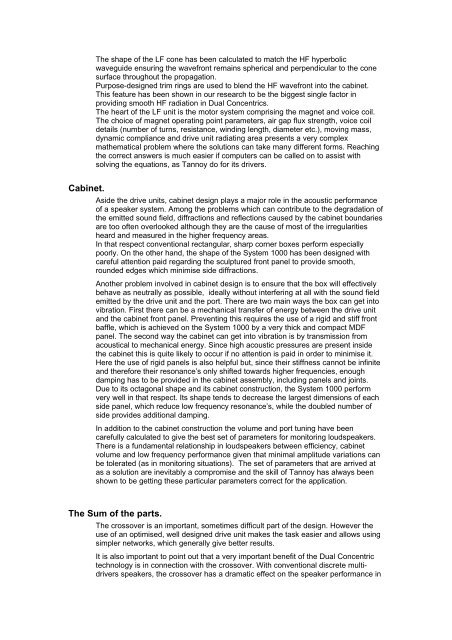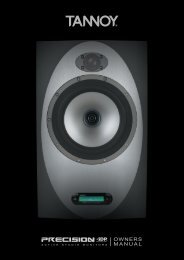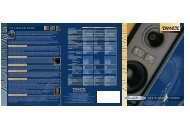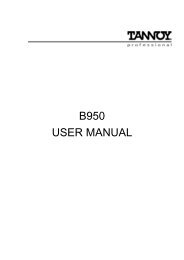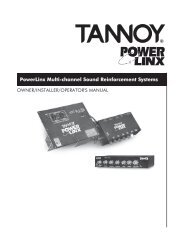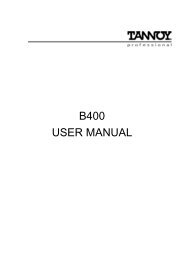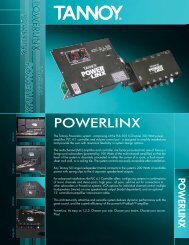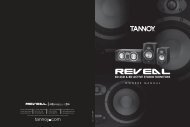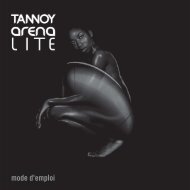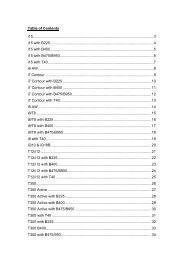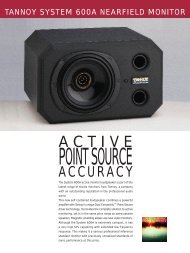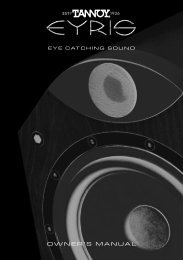REFERENCE MONITORS SYSTEM 1000 USER MANUAL - Tannoy
REFERENCE MONITORS SYSTEM 1000 USER MANUAL - Tannoy
REFERENCE MONITORS SYSTEM 1000 USER MANUAL - Tannoy
Create successful ePaper yourself
Turn your PDF publications into a flip-book with our unique Google optimized e-Paper software.
The shape of the LF cone has been calculated to match the HF hyperbolic<br />
waveguide ensuring the wavefront remains spherical and perpendicular to the cone<br />
surface throughout the propagation.<br />
Purpose-designed trim rings are used to blend the HF wavefront into the cabinet.<br />
This feature has been shown in our research to be the biggest single factor in<br />
providing smooth HF radiation in Dual Concentrics.<br />
The heart of the LF unit is the motor system comprising the magnet and voice coil.<br />
The choice of magnet operating point parameters, air gap flux strength, voice coil<br />
details (number of turns, resistance, winding length, diameter etc.), moving mass,<br />
dynamic compliance and drive unit radiating area presents a very complex<br />
mathematical problem where the solutions can take many different forms. Reaching<br />
the correct answers is much easier if computers can be called on to assist with<br />
solving the equations, as <strong>Tannoy</strong> do for its drivers.<br />
Cabinet.<br />
Aside the drive units, cabinet design plays a major role in the acoustic performance<br />
of a speaker system. Among the problems which can contribute to the degradation of<br />
the emitted sound field, diffractions and reflections caused by the cabinet boundaries<br />
are too often overlooked although they are the cause of most of the irregularities<br />
heard and measured in the higher frequency areas.<br />
In that respect conventional rectangular, sharp corner boxes perform especially<br />
poorly. On the other hand, the shape of the System <strong>1000</strong> has been designed with<br />
careful attention paid regarding the sculptured front panel to provide smooth,<br />
rounded edges which minimise side diffractions.<br />
Another problem involved in cabinet design is to ensure that the box will effectively<br />
behave as neutrally as possible, ideally without interfering at all with the sound field<br />
emitted by the drive unit and the port. There are two main ways the box can get into<br />
vibration. First there can be a mechanical transfer of energy between the drive unit<br />
and the cabinet front panel. Preventing this requires the use of a rigid and stiff front<br />
baffle, which is achieved on the System <strong>1000</strong> by a very thick and compact MDF<br />
panel. The second way the cabinet can get into vibration is by transmission from<br />
acoustical to mechanical energy. Since high acoustic pressures are present inside<br />
the cabinet this is quite likely to occur if no attention is paid in order to minimise it.<br />
Here the use of rigid panels is also helpful but, since their stiffness cannot be infinite<br />
and therefore their resonance’s only shifted towards higher frequencies, enough<br />
damping has to be provided in the cabinet assembly, including panels and joints.<br />
Due to its octagonal shape and its cabinet construction, the System <strong>1000</strong> perform<br />
very well in that respect. Its shape tends to decrease the largest dimensions of each<br />
side panel, which reduce low frequency resonance’s, while the doubled number of<br />
side provides additional damping.<br />
In addition to the cabinet construction the volume and port tuning have been<br />
carefully calculated to give the best set of parameters for monitoring loudspeakers.<br />
There is a fundamental relationship in loudspeakers between efficiency, cabinet<br />
volume and low frequency performance given that minimal amplitude variations can<br />
be tolerated (as in monitoring situations). The set of parameters that are arrived at<br />
as a solution are inevitably a compromise and the skill of <strong>Tannoy</strong> has always been<br />
shown to be getting these particular parameters correct for the application.<br />
The Sum of the parts.<br />
The crossover is an important, sometimes difficult part of the design. However the<br />
use of an optimised, well designed drive unit makes the task easier and allows using<br />
simpler networks, which generally give better results.<br />
It is also important to point out that a very important benefit of the Dual Concentric<br />
technology is in connection with the crossover. With conventional discrete multidrivers<br />
speakers, the crossover has a dramatic effect on the speaker performance in


